Having ousted the Carthaginians, Rome now had to contend with the local tribes in Hispania Ulterior, Iberians, Turdetani and Lusitanians
By Nick Nutter | Updated 8 Mar 2022 | Andalucia | History |
Login to add to YOUR Favourites or Read Later
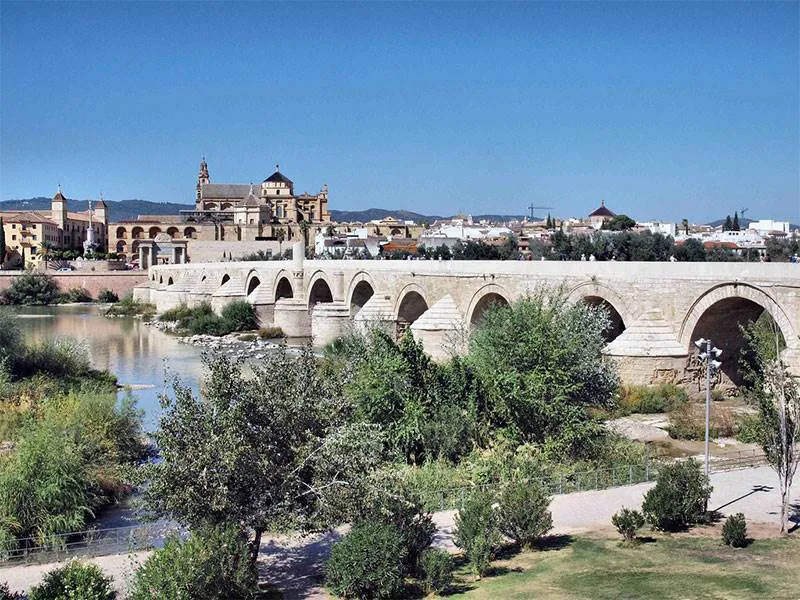
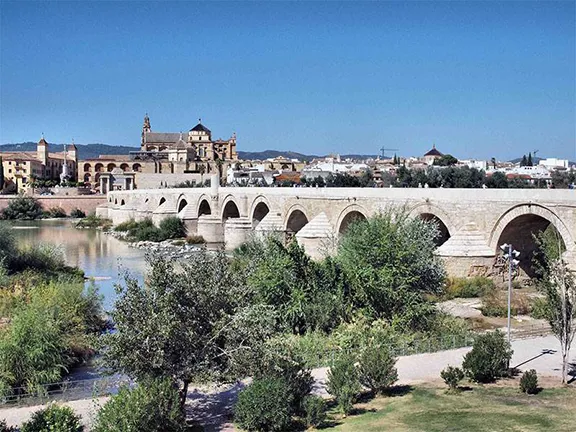
Roman bridge at Cordoba
Even though the Second Punic War was to drag on until 201 BC, the action after 205 BC took place outside Hispania Ulterior. With the bulk of the Roman army occupied outside the country, Roman consolidation of their territory in Hispania was limited until after the war.
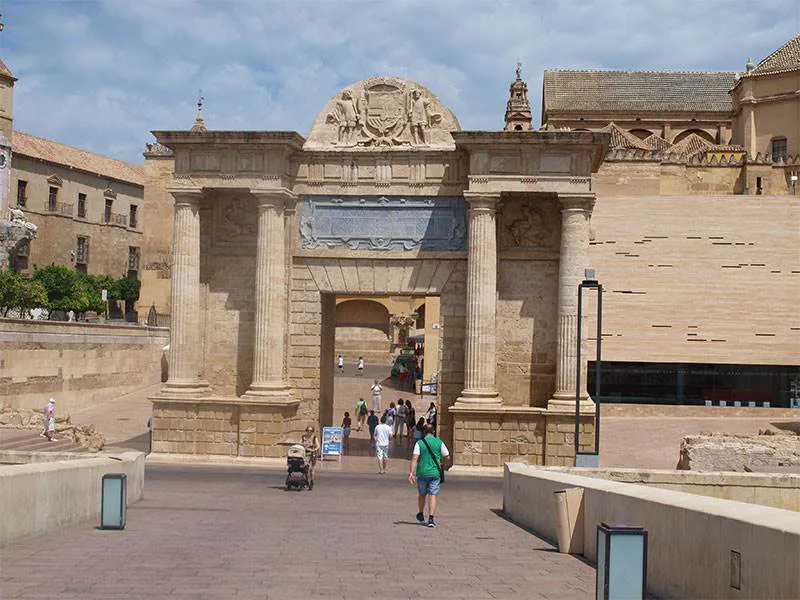
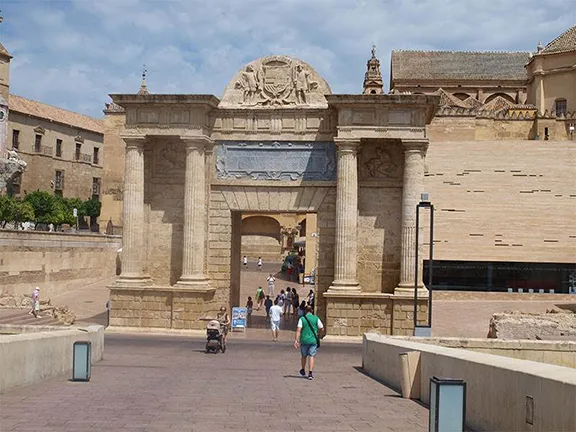
Roman gate at Cordoba
Italica was the first purpose-built Roman Colonia in Hispania, dating to 205 BC. It was intended initially for wounded veteran legionaries, following their victory the previous year over the Carthaginians at the battle of Ilipa, now the village of Alcalá del Rio, a few kilometres north of Seville. The veterans first occupied the site of a Turdetanian settlement called Cerro de San Antonio. The village was in a strategic position halfway between Hispalis, now the city of Seville, and Ilipa and on the route between the port of Huelva and the mining areas in the Sierra Norte.
Within a few years, Cerro de San Antonio had been Romanised and named Italica. During the reign of Hadrian (117 – 138 AD), whose family came from Italica, the town was granted the status of Colonia, a term that by then denoted a major city. This older part of Italica is mainly beneath the modern town of Santiponce although there are tantalising glimpses of it between the more modern buildings including a theatre reached by following signs through the narrow alleys.
Italica developed into a suburb of Hispalis and could be likened to Mayfair as a suburb of London, with large villas, many with elaborate and beautiful mosaics, a grand amphitheatre, wide streets, and luxurious baths, all on a broad rounded cliff overlooking the working town and port of Hispalis. The amphitheatre is one of the best-preserved examples in Spain and the fourth largest known from any part of the Roman Empire. It could seat 40,000 people. The subterranean passages and pits beneath the stage where animals and gladiators were hidden from the sight of the public are all still there.
Hadrian built the grand villas and public buildings you see today during the 1st Century AD. Hadrian’s family included his predecessor, Emperor Trajan (98 – 117 AD) who was also born in Italica. He and Hadrian became the first Roman emperors of provincial origin.
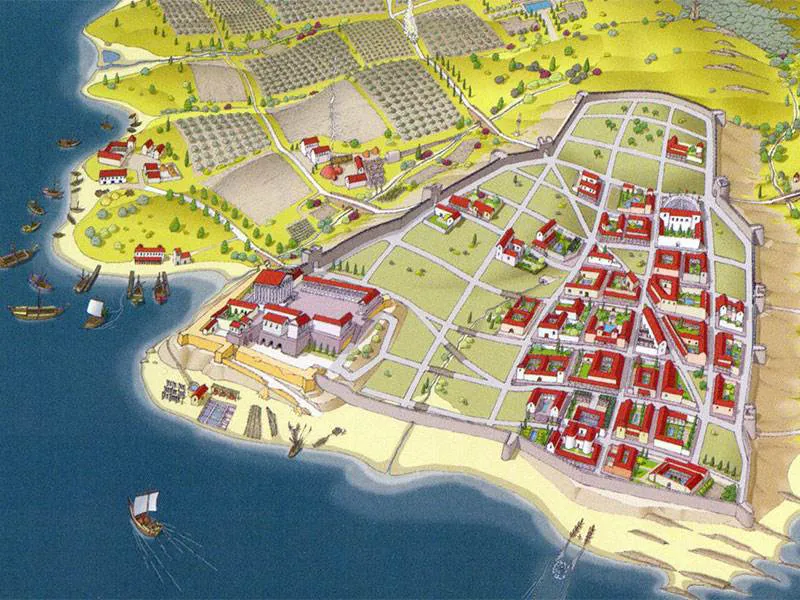
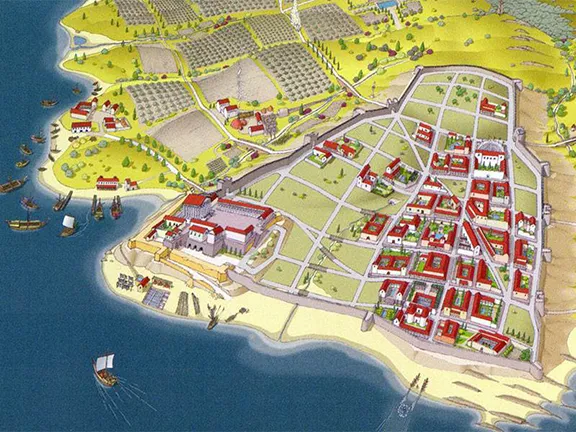
Map of Carteia
Existing cities, particularly those on the coast such as Málaga (Malaka) and Almuñecar (Sexi) that had been developed by the Phoenicians, were particularly prized. The Romans arrived in Malaka in 205 BC and were soon extending the defensive walls. In Sexi the Romans built the Castle of San Miguel with a bridge from the castle to the 'Peñon del Santo', a large rock outcrop projecting into the bay. The bridge had a 30-metre high arch that survived well into the 19th century AD.
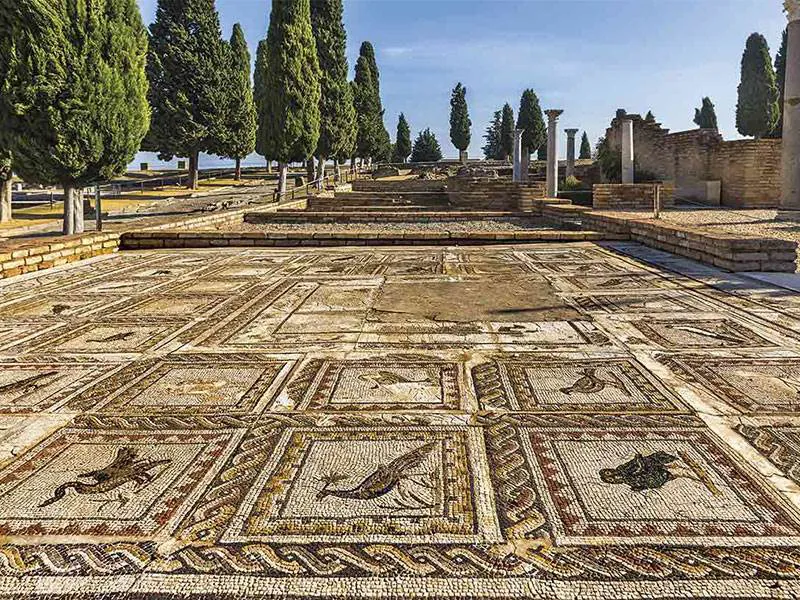
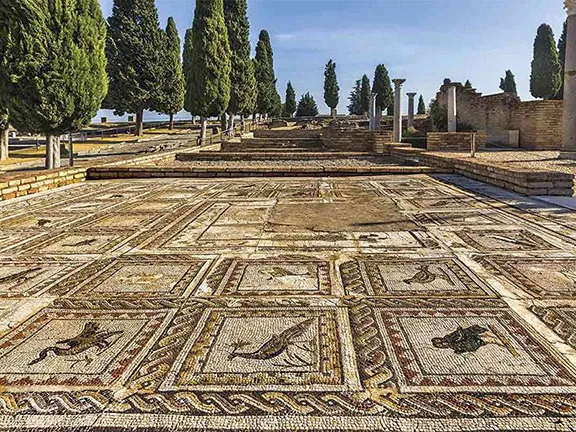
Mosaics at Italica
It did not take the Romans long to realise the value of the real estate they had just wrested from the Carthaginians. Having ousted the Cartaginians, they now had to contend with the local tribes. The Iberians were the dominant native group in Andalucia and consisted of several tribes primarily the Bastetani who occupied the present-day Almería and Granada regions and the most powerful tribe, the Turdetani, the remnants of the Tartessian civilisation, who were located in the Guadalquivir river valley. On the outskirts of modern-day Andalucia, there were the Lusitani to the north and west and much of present-day Portugal and the Celtiberians to the northeast. These tribes were by no means subdued and would not be for nearly 200 years.
Politically and culturally the Iberians were influenced by the Greek and Phoenician cultures they had contact with before the Romans arrived and had one of the two pre-Roman alphabets found in Hispania, the other being the Tartessian alphabet. Unlike the Tartessians, the Iberians never formed one state preferring the monarchy led city-state model of ancient Greece. The armies that these tribes could field consisted of cavalry supported by infantry armed with javelins, slings and dirks and wearing light armour. However, during the Phoenician – Greek period of over 600 years before the Romans arrived, the Iberians, Turdetani and the Tartessians before them had enjoyed a trading partnership with the Phoenicians and Greeks, neither of whom attempted to colonise, govern or subdue an area. All that changed with the arrival of the Carthaginians and then the Romans.
During the Second Punic War, the native tribes in Hispania had alternatively supported the Carthaginians or the Romans, depending on who at the time was offering the most rewards. Following the Second Punic war in Spain, the native tribes found their territory being increasingly occupied. The occupation was a deliberate act by the Roman Republic to prevent a return of the Carthaginian army, and then, after the war, a means to exploit the mineral and agricultural riches of the area.
During the Second Punic War, the conquered territories came under military rule by whichever commander was there at the time. After 206 BC, when Scipio returned to Rome, two proconsuls were appointed by Rome to command the armies in Hispania. This was an interim measure that was regularised four years after the war. In 197 BC, Hispania was divided into two, Hispania Citerior, that consisted of the conquered territories corresponding to modern-day Valencia, Catalonia and part of Aragón and Hispania Ulterior roughly corresponding to modern-day Andalucia. Each of the two areas was governed by praetors. Just before his departure back to Italy, Scipio had concluded a treaty with the city of Cádiz that allowed the city to be governed by a Roman Centurion as opposed to a prefect or praetor. In 199 BC this agreement was ratified by Rome. The city of Cordoba became the capital of Hispania Ulterior.
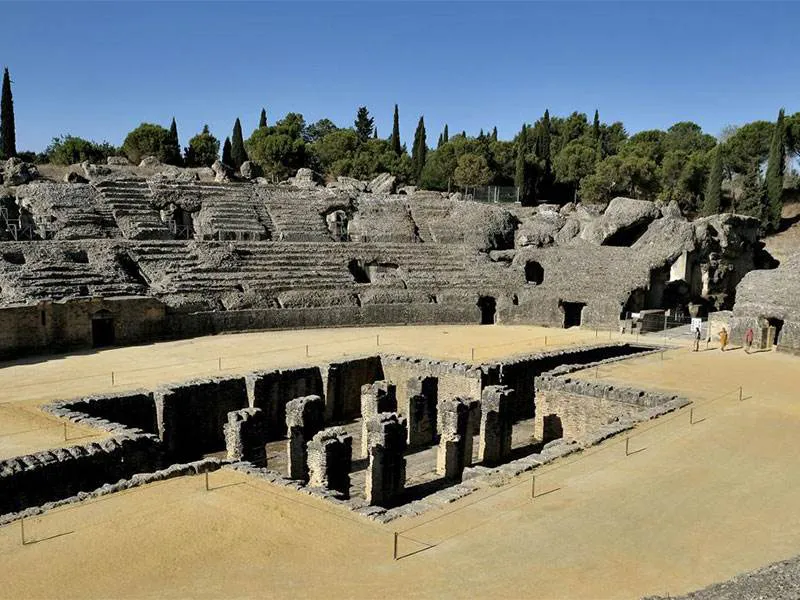
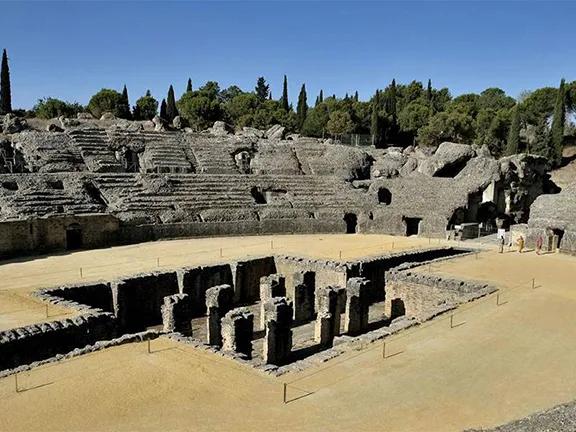
Amphitheatre at Italica
In 197 BC, Scipio’s policy of colonisation caused the Turdetani to rebel. The Turdetani rebellion inspired more tribes in Hispania Citerior to rise against the Romans. In Hispania Ulterior the revolt centred on an area around the Baetis controlled by two chiefs, Culchas and Luxinius. Culchas was supported by no less than fifteen fortified cities and Luxinius by two, Carmona and Bardo (location unknown).
Consul Marcus Porcius Cato was sent by Rome to take command of the whole peninsula and successfully put down the revolt returning to Rome in 194 BC leaving a praetor in charge of each of the two provinces. Cato’s procession through Rome included a baggage train that carried his spoils; 25,000 pounds weight of silver, 1,400 pounds weight of gold and 177,000 silver coins. Cato also paid his cavalry 1,610 bronze coins per man and his infantry 270 bronze coins per man. Cato was famously cruel whilst subduing the Turdetani with many accounts of massacres of surrendered victims and Cato himself claiming to have destroyed more towns in Hispania than he had spent days in the country.
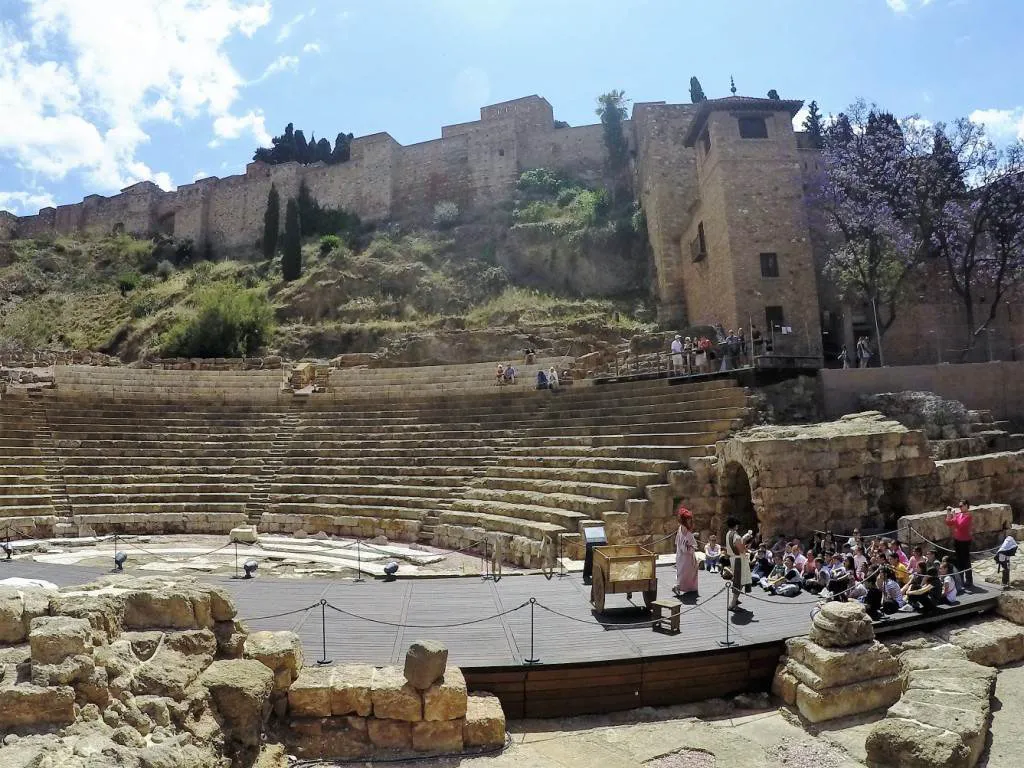
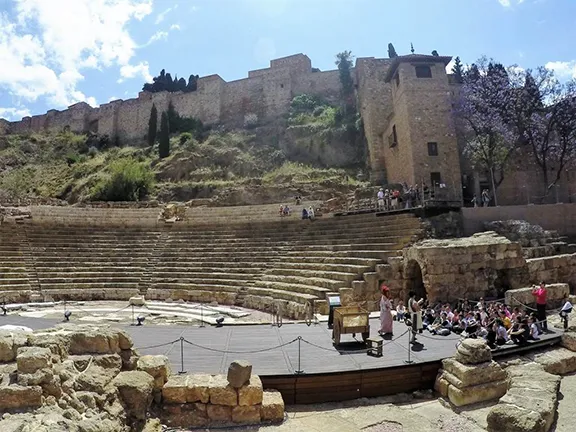
Theatre at Malaga
The Lusitani were next to take up arms against Rome and managed to penetrate Andalucia as far as the mouth of the Baetis (Guadalquivir) river in 189 BC. At times allied with the Celtiberians, the war, which was really a series of inconclusive skirmishes, dragged on until around 133 BC.
Probably the most famous figure to emerge was Viriathus, a Lusitanian shepherd who persuaded 10,000 Lusitanians to fight the Romans. He carried on a guerrilla war against enormous odds for eight years, eventually taking several towns in the Córdoba area. He was killed in 139 BC by one of his friends who had been bribed by the Romans to undertake the dirty deed.
Following the end of the Second Punic War in 201 BC, despite the skirmishes during the localised rebellions, Roman numbers in Hispania Ulterior, particularly in the more settled southern parts, had been increasing. A more significant Roman presence allowed some of the established native towns, previously ignored, or captured and then abandoned, to be colonised.
Carteia, just outside San Roque, was a well-established settlement when the Romans captured it from the Carthaginians in 206 BC. The Carthaginians had occupied this Turdetani town since 228 BC. Before that Carteia was a thriving port administered by the Phoenicians.
Carteia was resettled in 171 BC by 4,000 sons of Roman legionaries and local women and gained fame in 45 BC when it became one of the last refuges of Pompey. The port exported the local wine to all parts of the empire. Partly because of the wine trade an important amphorae factory was built there.
Córdoba (Corduba) is situated on the river Guadalquivir at the upstream limit of navigation. It was to become a major embarkation point for the grain and fruits of the upper Guadalquivir that were exported all over the Roman territories. Conquered in 206 BC, Córdoba was largely ignored until 169 BC when a Roman colony was founded alongside the Iberian settlement.
Between 143 and 141 BC, the Lusitanian commander, Viriatus, besieged Córdoba without taking the settlement. As mentioned above, Viriatus was murdered in 139 BC, after which the Lusitanian revolt was effectively over.